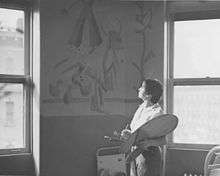Elba Lightfoot
Elba Lightfoot (born 1910) was an African-American artist known for her work on the WPA murals at Harlem Hospital.[1][2][3]
Elba Lightfoot | |
|---|---|
 Elba Lightfoot working on Mother Goose Rhymes, 1938 WPA mural at Harlem Hospital, New York, NY. From the collection of the Archives of American Art. | |
| Born | 1910 |
| Nationality | American |
| Known for | Muralist |
She was born in Evanston, Illinois. In 1935, together with Charles Alston, Augusta Savage (who had experienced discrimination in her artistic career), others artists and bibliophile Arthur Schomburg, Lightfoot founded the Harlem Artists Guild[4] to work towards equality in WPA art programs in New York.[5][6] She was among the artists who took part in the Exhibition of the Art of the American Negro (1851-1940) (July 4–September 2, 1940), connected with the American Negro Exposition, at the Tanner Art Galleries in Chicago.[7] She also featured in American Negro Art, 19th and 20th Centuries (December 9, 1941 – January 3, 1942) at New York's Downtown Gallery, the first exhibition of African-American art to have been held at a mainstream commercial gallery; curated by Edith Halpert, owner of the gallery, the exhibition counted among its sponsored such prominent white patrons as Mayor Fiorello La Guardia, Archibald MacLeish, A. Philip Randolph, and Eleanor Roosevelt.[8]
Elba Lightfoot appears in a group photograph of the artists of the WPA Art Center at 306 W. 141st St., New York.[9]
A 1988 oral history interview of Elba Lightfoot is in the Camille Billops and James V. Hatch Archives at Emory University.[10]
References
- "Elba Lightfoot". askART. Retrieved 2012-02-02.
- "Full text of 'The New Deal fine arts projects : a bibliography, 1933-1992'". Retrieved 2012-02-02. Berman, Greta. "Walls of Harlem." Arts 52 (October 1977): 122-26. "Account of six African-American artists (Charles Alston, Vertis Hayes, Georgette Seabrooke, Sara Murrell, Selma Day, and Elba Lightfoot) who worked on murals at the Harlem Hospital in 1936.
- "Harlem Hospital WPA Murals - The Artists: Introduction". Retrieved 2012-02-02.
- Sharon F. Patton, "Negro art organizations", African-American Art, Oxford University Press, 1998, p. 147.
- Pierce, Lemoine (2004). "Charles Alston – An Appreciation". The International Review of African American Art (4): 33–38.
- Wintz, Carrie D.; Paul Finkelman, eds. (2004). "Second Harlem Renaissance". Encyclopedia of the Harlem Rennassance. 1. New York: Routledge. p. 1100. ISBN 0-203-31930-3. Retrieved February 2, 2012.
- "DeReyes, Elba Lightfoot. (Evanston, IL, 1910-New York, NY, 1989)", Exhibition of the Art of the American Negro (1851-1940). AAVAD.com.
- "Lightfoot, Elba (De Reyes)", American Negro Art, 19th and 20th Centuries. AAVAD.com.
- "The artists of the 306 W. 141st Street WPA Art Center". Institute for Research in African-American Studies, Columbia University.
- "Elba Lightfoot interview, 1988, in Emory FindingAids : Camille Billops and James V. Hatch Archives at Emory University : Series 3: Artist and Influence oral history interviews". Retrieved 2012-02-02.
External links
- Toy Parade by Elba Lightfoot
- "Hatch, James V. and Leo Hamalian, eds. Artist and Influence Vol. 8: The Cornucopia (1989). New York: Hatch-Billops Collection, Inc., 1989. Elba Lightfoot interview". Retrieved 2012-02-02.
![]()